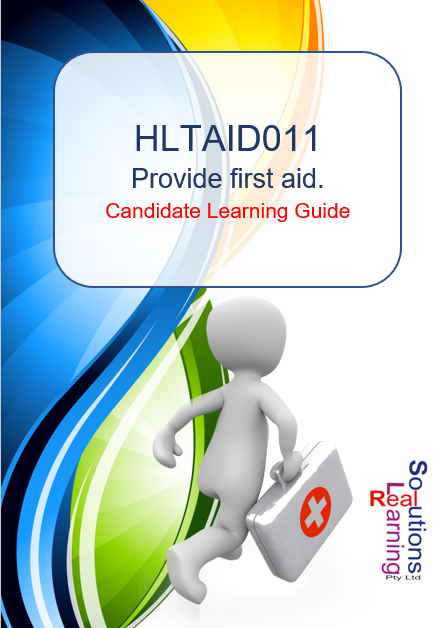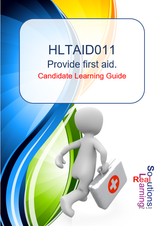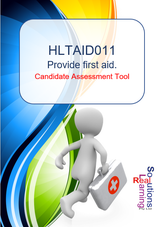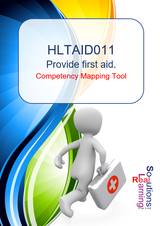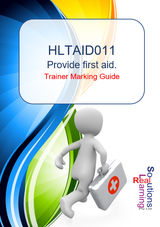- CHC - Community Services
- >
- CHC - Certificate III Level Qualifications
- >
- CHC32015 - Certificate III in Community Services
- >
- HLTAID011 Provide First Aid
HLTAID011 Provide First Aid
SKU:
HLTAID011
A$1,275.00
A$1,275.00
Unavailable
per item
This unit describes the skills and knowledge required to provide a first aid response to a casualty in line with first aid guidelines determined by the Australian Resuscitation Council (ARC) and other Australian national peak clinical bodies.
The unit applies to all persons who may be required to provide a first aid response in a range of situations, including community and workplace settings.
Specific licensing/regulatory requirements relating to this competency, including requirements for refresher training should be obtained from the relevant national/state/territory Work Health and Safety Regulatory Authorities.
What is included in the package?
The course we have produced includes the following:
- Candidate Learning Guide (Workbooks/Manuals)
- Candidate Assessment Tool
- Trainer Marking Guide
- PowerPoints
- Competency Mapping Tool
| sample_-_hltaid011_-_candidate_learning_guide.pdf | |
| File Size: | 6227 kb |
| File Type: | |
Performance Evidence
Evidence of the ability to complete tasks outlined in elements and performance criteria of this unit in the context of the workplace or community setting.
There must be evidence that the candidate has completed the following tasks in line with State/Territory regulations, first aid codes of practice, first aid guidelines determined by the Australian Resuscitation Council (ARC) and other Australian national peak clinical bodies and workplace or site procedures:
Demonstrated knowledge required to complete the tasks outlined in elements and performance criteria of this unit:
Each candidate to demonstrate skills in an environment that provides realistic in-depth, scenarios and simulations to assess candidates’ skills and knowledge.
Due to the nature of this type of training, it is acceptable for the performance evidence to be collected in a simulated environment.
Compression and ventilation skills must be demonstrated on resuscitation manikins following ARC guidelines for the purpose of assessment of CPR procedures.
Assessment must ensure access to:
Assessors must satisfy the Standards for Registered Training Organisations’ requirements for assessors and must hold this unit or demonstrate equivalent skills and knowledge to that contained within this unit.
Evidence of the ability to complete tasks outlined in elements and performance criteria of this unit in the context of the workplace or community setting.
There must be evidence that the candidate has completed the following tasks in line with State/Territory regulations, first aid codes of practice, first aid guidelines determined by the Australian Resuscitation Council (ARC) and other Australian national peak clinical bodies and workplace or site procedures:
- managed, in line with ARC guidelines, the unconscious, breathing casualty including appropriate positioning to reduce the risk of airway compromise
- managed, in line with ARC guidelines, the unconscious, non-breathing adult, including:
- performing at least 2 minutes of uninterrupted single rescuer cardiopulmonary resuscitation (CPR) (5 cycles of both compressions and ventilations) on an adult resuscitation manikin placed on the floor
- following the prompts of an automated external defibrillator (AED) to deliver at least one shock
- demonstrating a rotation of single rescuer operators with minimal interruptions to compressions
- responding appropriately in the event of regurgitation or vomiting
- managed, in line with ARC guidelines, the unconscious, non-breathing infant, including:
- performing at least 2 minutes of uninterrupted single rescuer CPR (5 cycles both compressions and ventilations) on an infant resuscitation manikin placed on a firm surface
- managed casualties, with the following:
- anaphylaxis
- asthma
- non-life-threatening bleeding
- choking
- envenomation, using pressure immobilisation
- fractures, dislocations, sprains and strains, using appropriate immobilisation techniques
- minor wound cleaning and dressing
- nosebleed
- shock
- responded to at least one simulated first aid incident contextualised to the candidate’s workplace or community setting, where the candidate has no knowledge of the casualty’s condition prior to starting treatment, including:
- identifying the casualty’s illness or injury through history, signs and symptoms
- using personal protective equipment (PPE) as required
- providing appropriate first aid treatment
- conveying incident details to emergency services or advising casualty on any required post incident action
- providing an accurate verbal and written report of the incident
- reviewing the incident.
Demonstrated knowledge required to complete the tasks outlined in elements and performance criteria of this unit:
- guidelines and procedures including:
- ARC guidelines relevant to the provision of first aid
- first aid guidelines from Australian national peak clinical bodies
- potential incident hazards and risk minimisation processes when providing first aid
- infection control procedures, including use of standard precautions and resuscitation barrier devices
- requirements for currency of skill and knowledge
- first aid codes of practice
- appropriate workplace or site procedures relevant to the provision of first aid
- contents of first aid kits
- legal, workplace and community considerations including:
- duty of care requirements
- own skills and limitations
- consent and how it relates to the conscious and unconscious casualty
- privacy and confidentiality requirements
- awareness of potential need for stress management techniques and available support for rescuers
- considerations when providing CPR, including:
- upper airway and effect of positional change
- appropriate duration and cessation of CPR
- appropriate use of an AED
- safety and maintenance procedures for an AED
- chain of survival
- how to access emergency services
- techniques for providing CPR to adults, children and infants including:
- how to recognise that a casualty is unconscious and not breathing normally
- rate, ratio and depth of compressions and ventilations
- correct hand positioning for compressions
- basic anatomy, physiology and the differences between adults, children and infants relating to CPR
- signs, symptoms and management of the following conditions and injuries:
- allergic reaction
- anaphylaxis
- asthma
- non-life-threatening and life-threatening bleeding
- burns
- cardiac conditions, including chest pain
- choking
- diabetes
- drowning
- envenomation - all current treatments
- eye injuries
- fractures, dislocations, strains and sprains
- head, neck and spinal injuries
- hypothermia
- hyperthermia
- minor wounds
- nose-bleed
- poisoning
- seizures
- shock
- sharps injuries
- stroke.
Each candidate to demonstrate skills in an environment that provides realistic in-depth, scenarios and simulations to assess candidates’ skills and knowledge.
Due to the nature of this type of training, it is acceptable for the performance evidence to be collected in a simulated environment.
Compression and ventilation skills must be demonstrated on resuscitation manikins following ARC guidelines for the purpose of assessment of CPR procedures.
Assessment must ensure access to:
- adult and infant resuscitation manikins following ARC guidelines for the purpose of assessment of CPR procedures
- adrenaline auto-injector training device
- AED training devices
- workplace first aid kit
- placebo bronchodilator and spacer device
- different types of wound dressings and bandages
- blankets and items to treat for shock
- personal protective equipment (PPE)
- workplace injury, trauma or illness record, or other applicable workplace or site incident report form.
Assessors must satisfy the Standards for Registered Training Organisations’ requirements for assessors and must hold this unit or demonstrate equivalent skills and knowledge to that contained within this unit.
